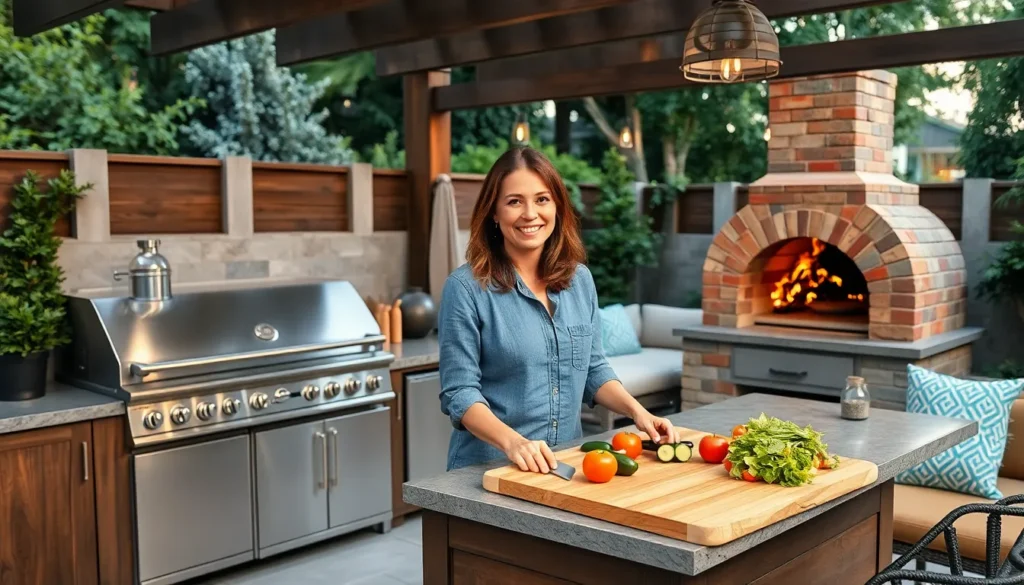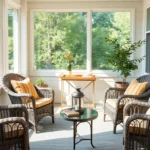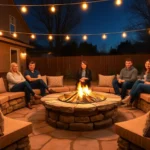We’ve all dreamed of hosting the perfect backyard gathering where delicious aromas fill the air and guests naturally gravitate toward the heart of outdoor entertaining. An outdoor kitchen transforms your backyard into a culinary paradise that extends your living space beyond four walls.
Whether you’re planning a complete outdoor kitchen renovation or looking for budget-friendly upgrades we’ll explore innovative ideas that fit every style and budget. From sleek modern designs with built-in grills to rustic setups featuring wood-fired pizza ovens these outdoor kitchen concepts will inspire your next home improvement project.
The best outdoor kitchens combine functionality with entertainment value creating spaces where cooking becomes part of the party. We’ll share practical design tips weatherproof material choices and clever storage answers that make outdoor cooking as convenient as your indoor kitchen while maximizing your outdoor living potential.
Essential Planning Considerations for Your Outdoor Kitchen Design
Before we jump into the exciting design elements, proper planning sets the foundation for a successful outdoor kitchen project that’ll serve you for years to come.
Determining Your Budget and Space Requirements
Setting a realistic budget guides every decision in your outdoor kitchen design process. We recommend allocating 10-15% of your home’s value for a comprehensive outdoor kitchen renovation, though costs can range from $5,000 for basic setups to $50,000+ for luxury installations.
Space requirements vary significantly based on your cooking style and entertainment needs. A basic outdoor kitchen needs minimum 8×10 feet, while elaborate designs with multiple cooking zones require 12×20 feet or larger. Consider these essential measurements:
| Kitchen Component | Minimum Space Required |
|---|---|
| Grill area | 3×6 feet |
| Prep counter | 2×4 feet |
| Storage cabinet | 2×3 feet |
| Seating area | 6×8 feet |
Evaluate your existing patio or deck space to determine if expansion is necessary. We suggest sketching your yard’s dimensions and noting utilities, trees, or structures that might impact your design.
Choosing the Right Location and Layout
Location selection impacts your outdoor kitchen’s functionality and your family’s enjoyment. We prioritize spots that offer easy access to your indoor kitchen, typically within 10-15 feet of your back door for convenient ingredient transport.
Wind patterns affect cooking comfort and safety, so observe your yard’s airflow throughout different seasons. Position your grill downwind from seating areas and consider installing windbreaks like pergolas or privacy screens.
Utility access simplifies installation and reduces costs significantly. Locate your outdoor kitchen near existing:
- Gas lines for grills and fire features
- Electrical outlets for lighting and appliances
- Water connections for sinks and ice makers
- Drainage systems for cleanup areas
Traffic flow between cooking, dining, and entertainment zones creates a seamless outdoor experience. We recommend the triangle concept: positioning your grill, sink, and prep area within easy reach of each other.
Understanding Local Building Codes and Permits
Building codes protect your investment and ensure safety compliance for outdoor kitchen installations. We always recommend checking with your local building department before beginning construction, as regulations vary by municipality.
Permit requirements typically apply to:
- Permanent structures exceeding certain square footage
- Gas line installations and modifications
- Electrical work including 220V connections
- Plumbing additions for sinks and water features
- Structural changes to existing patios or decks
Setback requirements determine how close your outdoor kitchen can be to property lines, typically 5-10 feet from boundaries. Fire safety codes specify minimum distances between grills and combustible materials, usually requiring 10 feet clearance from your home’s exterior.
Professional consultation with contractors familiar with local codes saves time and prevents costly mistakes. We suggest obtaining multiple quotes and verifying each contractor’s licensing and insurance before making decisions.
Must-Have Appliances for Your Dream Outdoor Kitchen
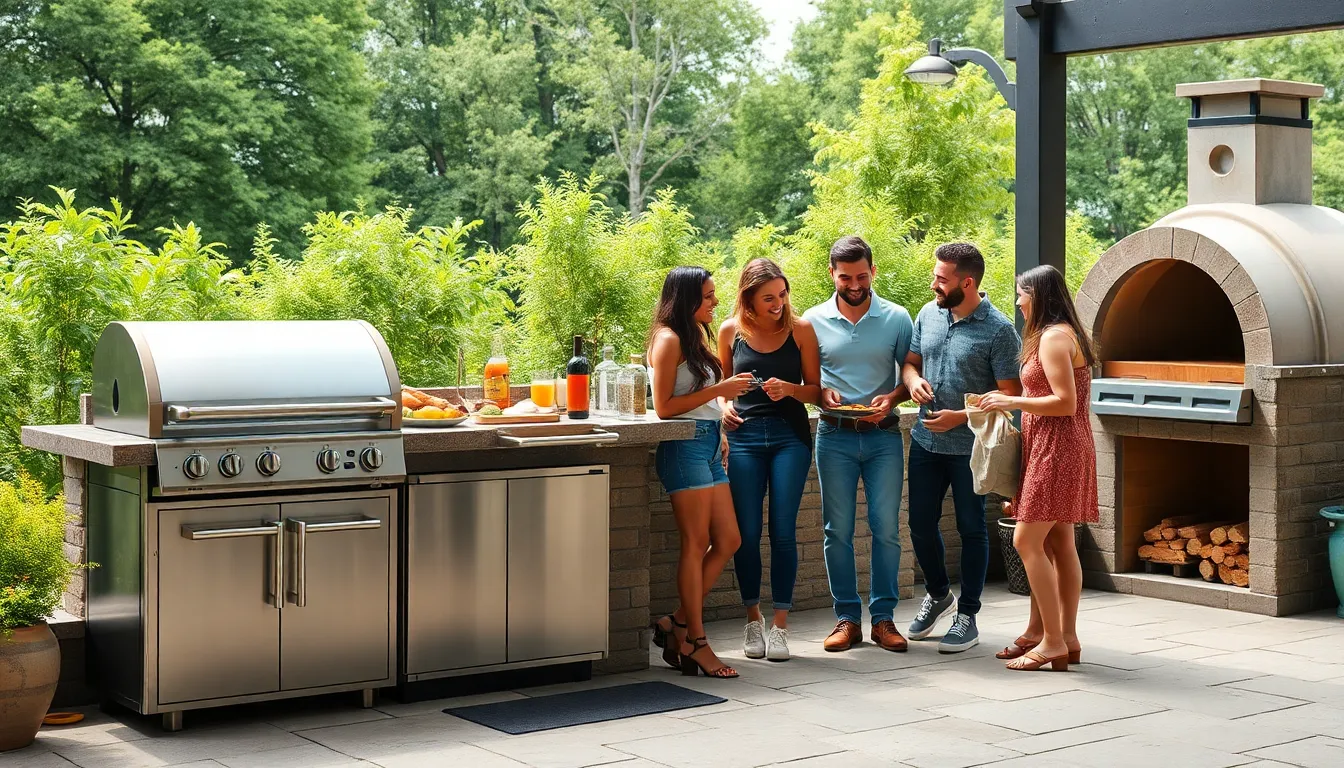
Building the perfect outdoor kitchen requires selecting appliances that’ll withstand the elements while delivering exceptional performance. We’ve identified the most essential pieces that transform any backyard into a culinary haven.
High-Performance Outdoor Grills and Smokers
Gas grills provide instant heat control and convenience for weeknight cooking and weekend entertaining. These versatile units offer multiple burners, side burners for sauces, and ample cooking space for large gatherings. Premium models include features like rotisserie attachments, infrared searing stations, and built-in temperature gauges.
Charcoal grills deliver that authentic smoky flavor outdoor cooking enthusiasts crave. Weber kettle grills and Big Green Egg ceramic cookers offer superior heat retention and versatility for both grilling and smoking applications. These units excel at low-and-slow cooking methods that create tender, flavorful results.
Pellet grills combine the convenience of gas with the flavor of wood smoke. Traeger and Camp Chef models use wood pellets to maintain consistent temperatures while infusing food with natural wood flavors like hickory, apple, and mesquite.
Dedicated smokers take outdoor cooking to the next level with their ability to slow cook meats for hours. Offset smokers, vertical water smokers, and electric smokers each offer unique advantages for creating restaurant-quality barbecue at home. These appliances add rich, complex flavors that can’t be replicated indoors.
Weather-Resistant Refrigeration Answers
Outdoor refrigerators keep beverages cold and ingredients fresh throughout your cooking session. Stainless steel models with marine-grade construction resist rust and corrosion in humid conditions. Popular brands like Sub-Zero and Marvel offer units designed specifically for outdoor environments.
Wine coolers maintain optimal temperatures for your favorite bottles while entertaining guests. Dual-zone models accommodate both red and white wines at their ideal serving temperatures. Built-in units integrate seamlessly with outdoor cabinetry for a professional appearance.
Ice makers ensure you’ll never run out of ice during parties and gatherings. Nugget ice makers produce restaurant-style ice that’s perfect for cocktails and soft drinks. Commercial-grade models can produce up to 50 pounds of ice daily.
Beverage centers combine refrigeration with convenient storage for frequently used items. These compact units fit under counters and feature glass doors for easy viewing. Some models include built-in tap systems for draft beer service.
Outdoor Pizza Ovens and Fire Features
Wood-fired pizza ovens create authentic Neapolitan-style pizzas with crispy crusts and perfectly melted cheese. Brick ovens like those from Mugnaini reach temperatures exceeding 900°F, cooking pizzas in just 90 seconds. These versatile units also excel at roasting vegetables, baking bread, and slow-cooking meats.
Gas-powered pizza ovens offer convenience without sacrificing flavor quality. Ooni and Roccbox models heat up quickly and maintain consistent temperatures for reliable results. These portable options work well for smaller spaces or renters who can’t install permanent fixtures.
Fire pits create gathering spaces that extend outdoor entertaining into cooler months. Gas fire pits provide instant flames with easy control, while wood-burning versions offer crackling sounds and authentic campfire experiences. Popular designs include round stone pits, rectangular modern styles, and portable copper bowls.
Outdoor fireplaces serve as dramatic focal points while providing warmth and ambiance. Built-in stone fireplaces complement traditional outdoor kitchen designs, while modern steel units suit contemporary spaces. Many models include cooking grates for grilling over open flames.
Creative Counter and Storage Solutions
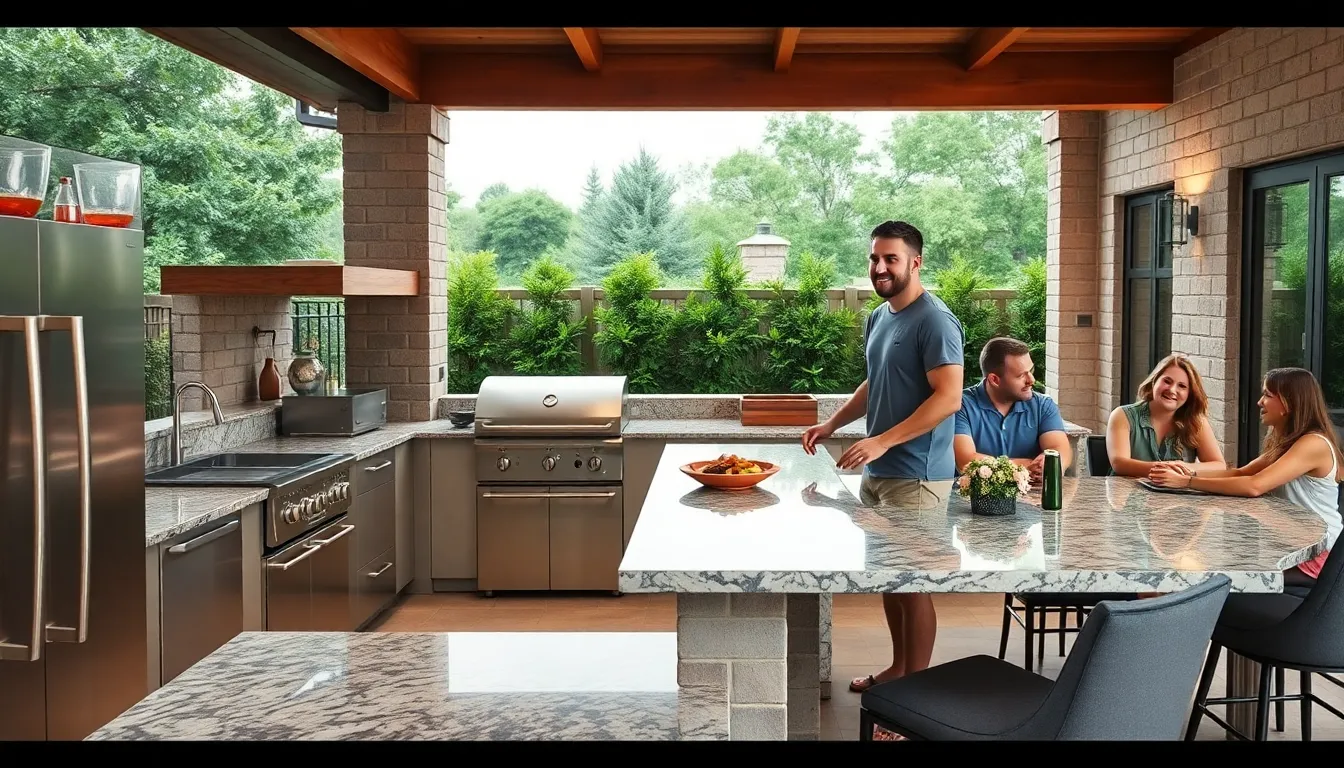
We’ll help you maximize your outdoor kitchen’s potential with innovative counter layouts and smart storage systems. Modern outdoor cooking spaces demand answers that blend functionality with weather resistance.
Durable Countertop Materials That Withstand the Elements
Weather-resistant materials form the foundation of any successful outdoor kitchen counter design. Granite tops the list for natural stone options, offering classic aesthetics and robust performance against UV rays, moisture, and temperature fluctuations. Quartz surfaces provide exceptional durability with minimal maintenance requirements, making them ideal for busy outdoor cooking spaces.
Concrete countertops allow for complete customization of shapes and finishes while maintaining excellent weather resistance. Stainless steel delivers a sleek, professional appearance with unmatched ease of cleaning and maintenance. Each material offers unique benefits, but all excel in withstanding outdoor elements that would quickly damage indoor alternatives.
Smart Storage Options for Outdoor Cooking Equipment
Waterproof cabinets protect your valuable cooking equipment from harsh weather conditions while keeping your outdoor space organized. Lockable drawers provide secure storage for expensive tools and accessories, giving you peace of mind when entertaining guests. Built-in compartments specifically designed for charcoal, propane tanks, and grill accessories streamline your cooking process.
Weatherproof bins offer flexible storage answers that can adapt to your changing needs throughout different seasons. Hidden storage beneath counters maintains a clean, minimalist appearance while maximizing available space. Vertical storage spaces use wall areas effectively, keeping frequently used items within easy reach during food preparation.
Multi-Functional Kitchen Islands and Bar Areas
Central workstations serve multiple purposes by combining food prep, grilling, and socializing in one convenient location. Integrated bar tops with comfortable seating create inviting gathering spots where guests can interact with the chef during meal preparation. Built-in sinks eliminate trips back to the indoor kitchen for cleaning tasks and food preparation needs.
Refrigerator integration within kitchen islands keeps beverages and ingredients at the perfect temperature throughout your outdoor cooking experience. Grill placement within islands centralizes cooking operations while providing additional counter space on either side. Modular designs enable you to customize counter shapes and heights based on your exact cooking style and entertainment preferences.
Stylish Design Themes to Match Your Home’s Aesthetic
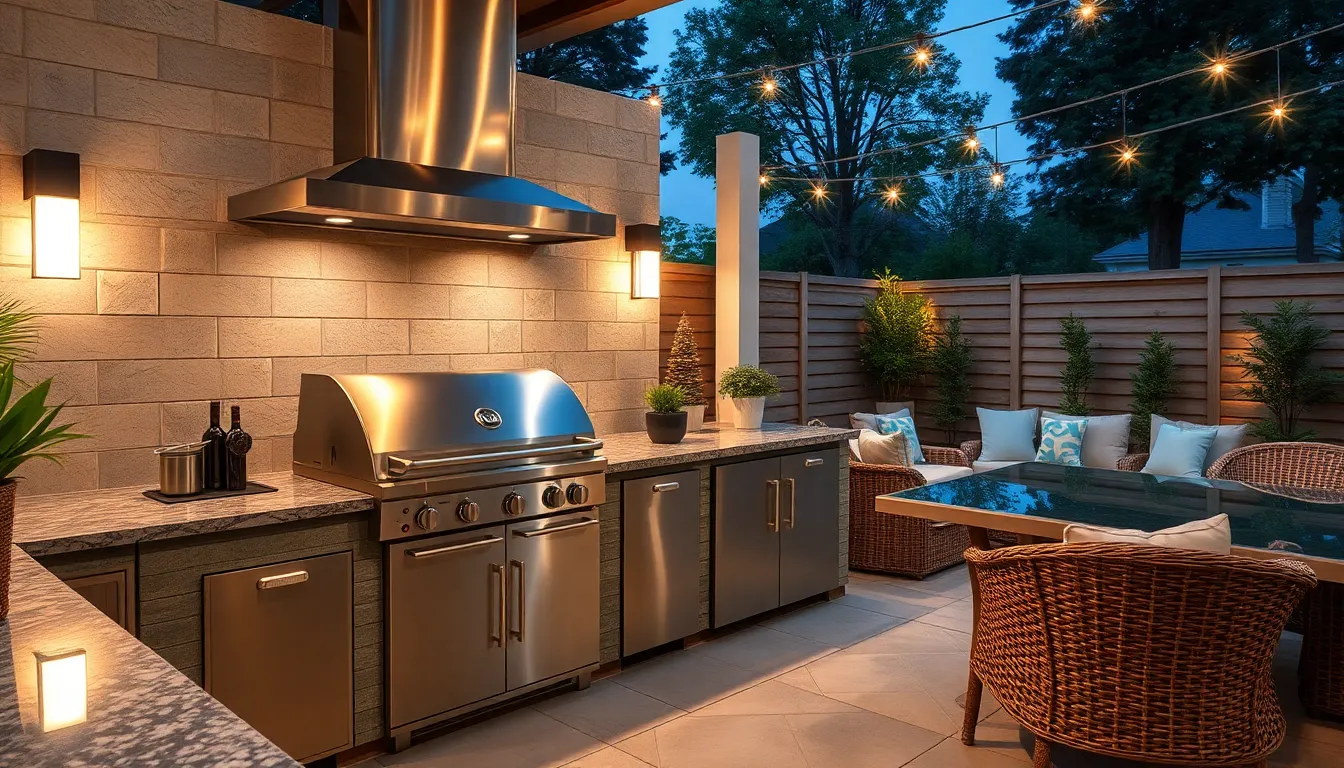
Choosing the right design theme ensures your outdoor kitchen seamlessly integrates with your home’s existing architecture and personal style. We’ll explore three popular aesthetic approaches that can transform any backyard space into a cohesive outdoor entertaining area.
Modern Minimalist Outdoor Kitchen Concepts
Clean lines and simple materials define the foundation of contemporary outdoor kitchen design. Stainless steel appliances and countertops create a sleek appearance that resists weather damage while maintaining professional-grade functionality.
Minimalist color palettes focus on neutral tones like white, gray, and black to establish visual continuity throughout the cooking space. These colors provide versatility when selecting accessories and make the area feel larger and more organized.
LED lighting systems enhance the modern aesthetic without adding visual clutter to your outdoor kitchen. Strategic placement of these fixtures creates ambient illumination for evening entertaining while highlighting key design elements like countertops and cooking surfaces.
Rustic and Traditional Country Kitchen Styles
Natural materials like wood, stone, and brick form the cornerstone of country-inspired outdoor kitchens. These elements create a warm, inviting atmosphere that complements traditional home architecture and provides excellent durability in outdoor environments.
Vintage accents such as copperware and traditional decor pieces emphasize the authentic country aesthetic. Incorporating these elements adds character while maintaining the functional aspects of your outdoor cooking space.
Warm color tones including brown, beige, and red evoke comfort and create visual harmony with natural surroundings. These earthy hues work particularly well with wooden pergolas, stone backsplashes, and brick pizza ovens.
Mediterranean and Tropical Paradise Designs
Bright colors and varied textures bring energy to Mediterranean-inspired outdoor kitchens through vibrant tiles, colorful ceramics, and natural fiber elements. These materials create visual interest while withstanding outdoor conditions and UV exposure.
Wicker and rattan furniture pieces add authentic tropical flair to your outdoor entertaining space. This furniture style complements cooking areas while providing comfortable seating for guests during meal preparation and dining.
Lush plants and vertical gardens enhance the paradise theme by creating natural privacy screens and improving air quality. Strategic placement of greenery around cooking areas softens hard surfaces while maintaining easy access to appliances and work zones.
Weather Protection and Shelter Ideas

Creating a durable outdoor kitchen means investing in proper weather protection that shields your investment from rain, sun, and temperature extremes. We’ll explore the most effective shelter answers that keep your cooking space functional year-round.
Pergolas and Gazebo Structures for Shade
Pergolas provide classic architectural appeal with their signature crisscross slat design that filters sunlight naturally. These open-air structures create partial shade while maintaining an airy atmosphere perfect for casual outdoor cooking. We can enhance basic pergolas with transparent, waterproof covers to add rain and hail protection without sacrificing the open feel.
Gazebos deliver superior overhead coverage compared to traditional pergolas. These more enclosed structures offer better shelter from both sun and rain, making them ideal for areas with unpredictable weather patterns. Most gazebos feature solid roofing that provides complete protection during storms.
Material considerations focus on weather-resistant options like treated wood, aluminum, or vinyl. Stainless steel hardware ensures long-lasting durability in outdoor conditions, while rust-resistant finishes protect structural integrity over time.
Retractable Awnings and Canopy Systems
Retractable awnings offer flexible control over your outdoor kitchen’s exposure to elements. These systems extend to protect against rain and UV rays, then retract completely to open your space to sunlight when desired. Manual or motorized options provide convenience based on your preferences and budget.
ShadeFX canopy systems install over pergolas or custom structures using durable fabrics like Sunbrella. These retractable answers combine weather protection with aesthetic appeal, offering customizable coverage that adapts to changing conditions throughout the day.
Installation versatility allows these systems to work with existing structures or new builds. We recommend professional installation to ensure proper tension and drainage, preventing water pooling and fabric damage during heavy rainfall.
Enclosed Outdoor Kitchen Pavilions
Enclosed pavilions represent the most comprehensive weatherproof solution for serious outdoor cooking enthusiasts. These structures feature solid roofs and optional glass or screened walls that provide year-round comfort and complete protection from elements.
Climate control capabilities make enclosed pavilions suitable for all-season use. We can integrate heating or cooling systems to maintain comfortable temperatures, extending your outdoor cooking season significantly beyond traditional setups.
Privacy and wind protection create intimate entertaining spaces that shield guests from harsh weather conditions. These fully enclosed designs allow for greater functionality during storms, ensuring your outdoor kitchen remains usable regardless of weather patterns.
Material specifications emphasize non-porous, rust-resistant components like stainless steel for appliances and cabinetry. Granite, quartzite, and porcelain countertops resist weather damage while concrete and treated wood provide structural resilience for long-term durability.
Lighting and Electrical Considerations
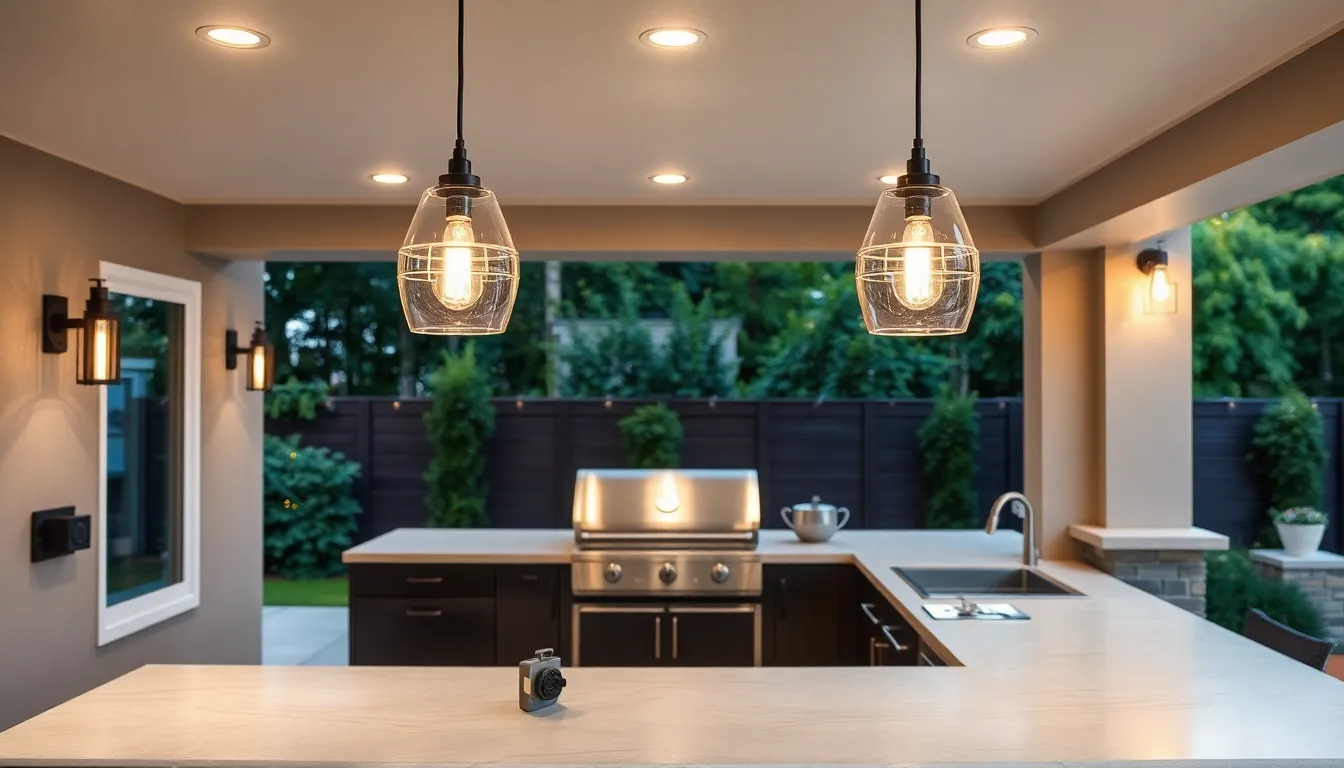
Creating a safe and functional outdoor kitchen requires careful attention to lighting design and electrical infrastructure. We’ll help you illuminate your cooking space while ensuring all electrical components meet safety standards.
Task Lighting for Food Preparation Areas
Recessed lighting provides the most effective illumination for food preparation zones in outdoor kitchens. We recommend installing these fixtures directly above countertops where you’ll be chopping vegetables or seasoning meats. Under-cabinet lights offer additional focused illumination that eliminates shadows during detailed cooking tasks.
Downlights excel at creating bright work zones over grilling stations and prep areas. Installing these fixtures ensures you can safely handle knives and cooking tools even after sunset. LED downlights deliver superior performance while consuming less energy than traditional bulbs.
Track lighting systems allow us to adjust beam direction based on cooking activities. These versatile fixtures can spotlight different work areas as needed throughout meal preparation. Adjustable heads make it easy to redirect light from the grill to the cutting board without rewiring.
Ambient Lighting for Evening Entertainment
String lights transform outdoor kitchens into magical entertainment spaces during evening gatherings. We suggest draping these decorative lights along pergola beams or fence lines to create warm ambient glow. Edison bulb string lights add vintage charm while providing sufficient illumination for casual dining.
Pendant lights serve as stunning focal points above kitchen islands or bar areas. These hanging fixtures create intimate lighting zones perfect for cocktail preparation and conversation. Choose weather-resistant designs that complement your outdoor kitchen’s architectural style.
Wall sconces outline outdoor kitchen perimeters while adding elegant accent lighting. Installing these fixtures on exterior walls or privacy screens creates defined boundaries for your cooking space. Decorative sconces enhance the overall aesthetic during both day and evening use.
Chandeliers bring sophisticated ambiance to covered outdoor dining areas. We recommend installing these statement pieces in gazebos or pavilions where they’re protected from direct weather exposure. Rustic or modern chandelier styles can reinforce your chosen design theme.
Proper Electrical Planning and Safety Features
GFCI outlets are essential safety components that must be installed near any water sources in outdoor kitchens. We always place these Ground Fault Circuit Interrupters within easy reach of sinks and ice makers to prevent electrical shock hazards. Professional installation ensures these outlets function properly in wet conditions.
Strategic outlet placement accommodates all appliances and lighting fixtures without creating extension cord hazards. We recommend installing outlets every 4 feet along countertop areas to support blenders, coffee makers, and other small appliances. Weatherproof outlet covers protect connections from moisture damage.
Proper grounding prevents electrical shock by providing safe pathways for stray current. All electrical installations require grounding connections that meet local building codes. Licensed electricians ensure grounding systems function correctly in outdoor environments.
Weather-resistant materials protect all electrical components from moisture and temperature extremes. We use waterproof junction boxes and outdoor-rated wiring throughout outdoor kitchen installations. Overhead protection shields fixtures from direct rain exposure while maintaining proper ventilation.
Dimmable controls provide lighting flexibility for different occasions and times of day. Installing dimmer switches allows you to create bright task lighting during food prep or soft ambient lighting during dinner parties. LED compatible dimmers ensure smooth operation with energy efficient bulbs.
Water Features and Plumbing Integration
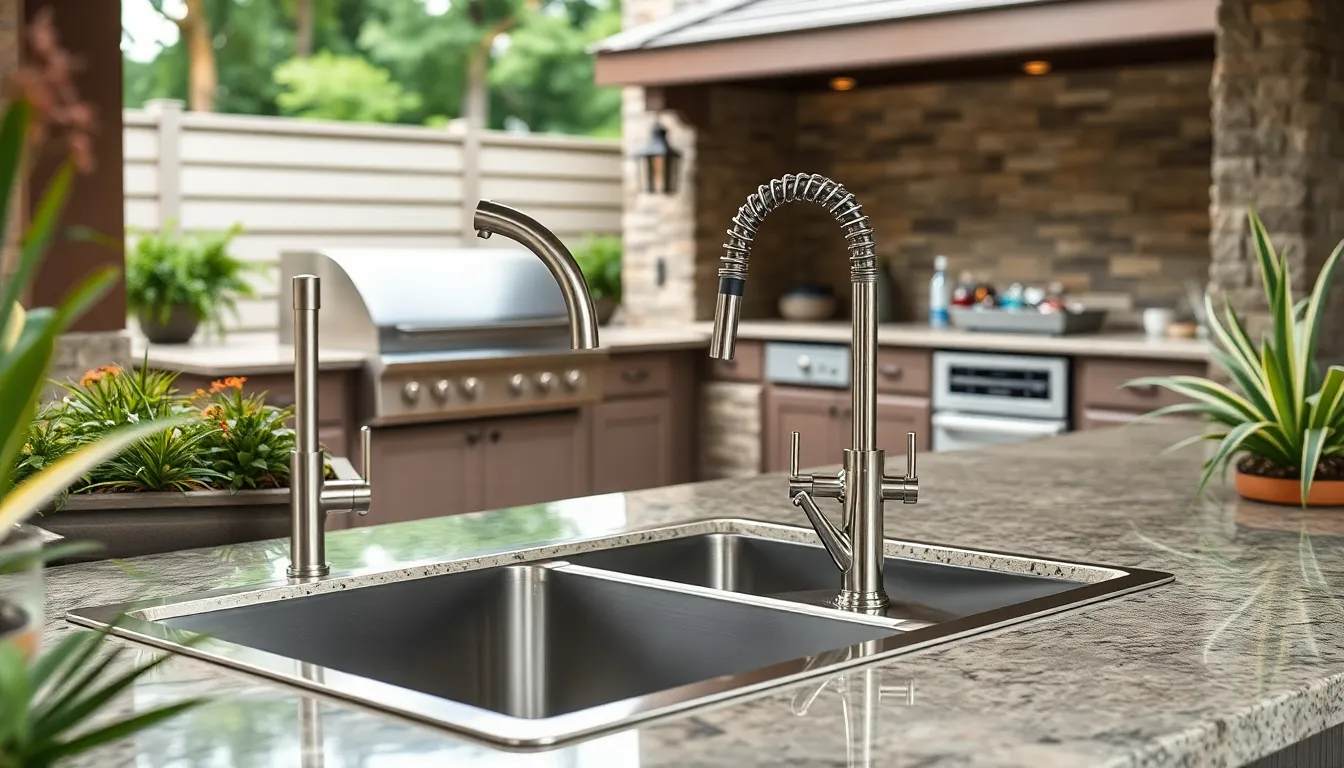
Building on the electrical foundation we’ve established, we’ll now focus on the plumbing elements that transform your outdoor kitchen into a fully functional culinary space. Water features and proper plumbing integration are essential for creating a seamless outdoor cooking and entertainment experience.
Installing Outdoor Sinks and Faucets
Stainless steel sinks offer exceptional durability and style for outdoor kitchens, while granite options provide a more elegant aesthetic that complements natural outdoor elements. We recommend choosing materials that can withstand temperature fluctuations and UV exposure without compromising functionality.
Weather resistant faucets with anti-scald features are crucial for outdoor installations, as they protect users from temperature variations that can occur in exposed plumbing lines. Careful planning of plumbing ensures seamless water supply and drainage systems that won’t freeze during colder months.
Professional installation becomes necessary for proper water line connections and drainage answers that comply with local building codes. Strategic placement near your main cooking area maximizes efficiency while maintaining the aesthetic flow of your outdoor kitchen design.
Ice Makers and Beverage Stations
Built in ice makers provide the convenience of fresh ice directly at your outdoor cooking station, eliminating trips back to your indoor kitchen during gatherings. These appliances require dedicated water lines and proper drainage to function efficiently in outdoor environments.
Wet bar installations create dedicated beverage preparation areas that can include wine coolers, refrigerated drawers, and specialty beverage equipment. Incorporating these features elevates your outdoor dining experience by providing restaurant quality service capabilities.
Dedicated beverage areas should include adequate counter space for mixing drinks, storage for glassware, and easy access to ice and refrigeration. We suggest positioning these stations away from heavy cooking areas to prevent cross contamination and improve workflow efficiency.
Dishwashing and Cleanup Answers
Large outdoor sinks serve as practical alternatives to built in dishwashers, which are often impractical for outdoor installations due to plumbing complexity and weather exposure concerns. These sinks should be deep enough to accommodate large pots and grilling equipment.
Designated trash and recycling bins maintain cleanliness and organization in your outdoor kitchen space, preventing waste from accumulating on prep surfaces. Built in answers that hide bins within cabinetry create a cleaner aesthetic while keeping disposal options easily accessible.
Cleanup stations should include adequate lighting, soap dispensers, and towel storage to create a complete washing area. Positioning these areas downstream from food preparation zones ensures proper workflow and prevents contamination during cooking processes.
Flooring Options That Combine Style and Function
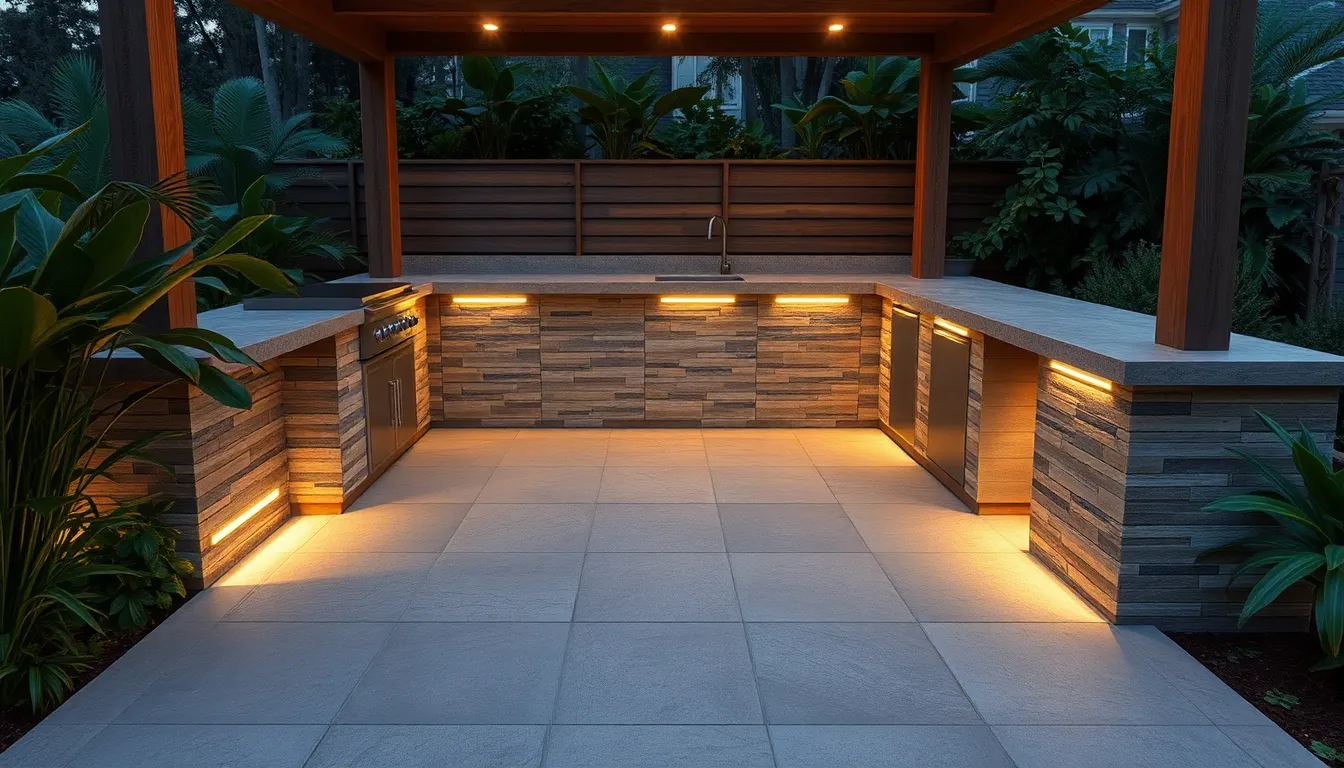
Creating a safe and beautiful foundation for your outdoor kitchen requires choosing materials that can handle weather extremes while complementing your design vision. We’ll explore the best flooring choices that deliver both performance and aesthetic appeal.
Non-Slip Surfaces for Safety
Textured concrete delivers exceptional grip underfoot while maintaining a sophisticated appearance that works with any outdoor kitchen design. This slip-resistant surface reduces accident risks in areas prone to moisture from cooking activities or weather exposure.
Rubber flooring provides flexible cushioning and superior traction, making it ideal for high-traffic zones around grills and prep areas. The material’s resilience helps prevent fatigue during extended cooking sessions while offering easy maintenance.
Natural stone with honed finishes creates texture without sacrificing elegance, ensuring guests can move safely around your outdoor kitchen. Materials like granite and travertine offer natural slip resistance when properly finished for outdoor use.
Easy-to-Clean Materials for High-Traffic Areas
Porcelain tiles resist moisture and staining while mimicking the appearance of natural stone at a fraction of the cost. These versatile surfaces handle frequent cleaning without showing wear, making them perfect for busy outdoor kitchens.
Concrete pavers offer cost-effective durability with design flexibility, allowing you to create custom patterns that complement your outdoor space. The material can be stained or painted to match surrounding elements while maintaining easy maintenance.
Sealed natural stone provides timeless beauty with practical benefits, as proper sealing prevents stains and makes cleaning effortless. Granite and marble surfaces withstand heavy use while adding luxury appeal to your outdoor kitchen.
Decorative Elements That Enhance Your Design
Mediterranean-style terracotta tiles introduce warm earth tones and traditional charm that pairs beautifully with rustic outdoor kitchen designs. These decorative elements create visual interest while maintaining the functional benefits of ceramic materials.
Integrated lighting strips within flooring transitions add both safety and ambiance, illuminating pathways between cooking zones during evening entertaining. LED strips embedded in floor borders create subtle guidance without overwhelming your design.
Patterned concrete finishes allow you to incorporate decorative borders and geometric designs that tie your flooring to your overall outdoor kitchen aesthetic. Stamped or stenciled patterns add visual appeal without compromising the material’s durability and slip resistance.
Seating and Dining Areas for Entertainment
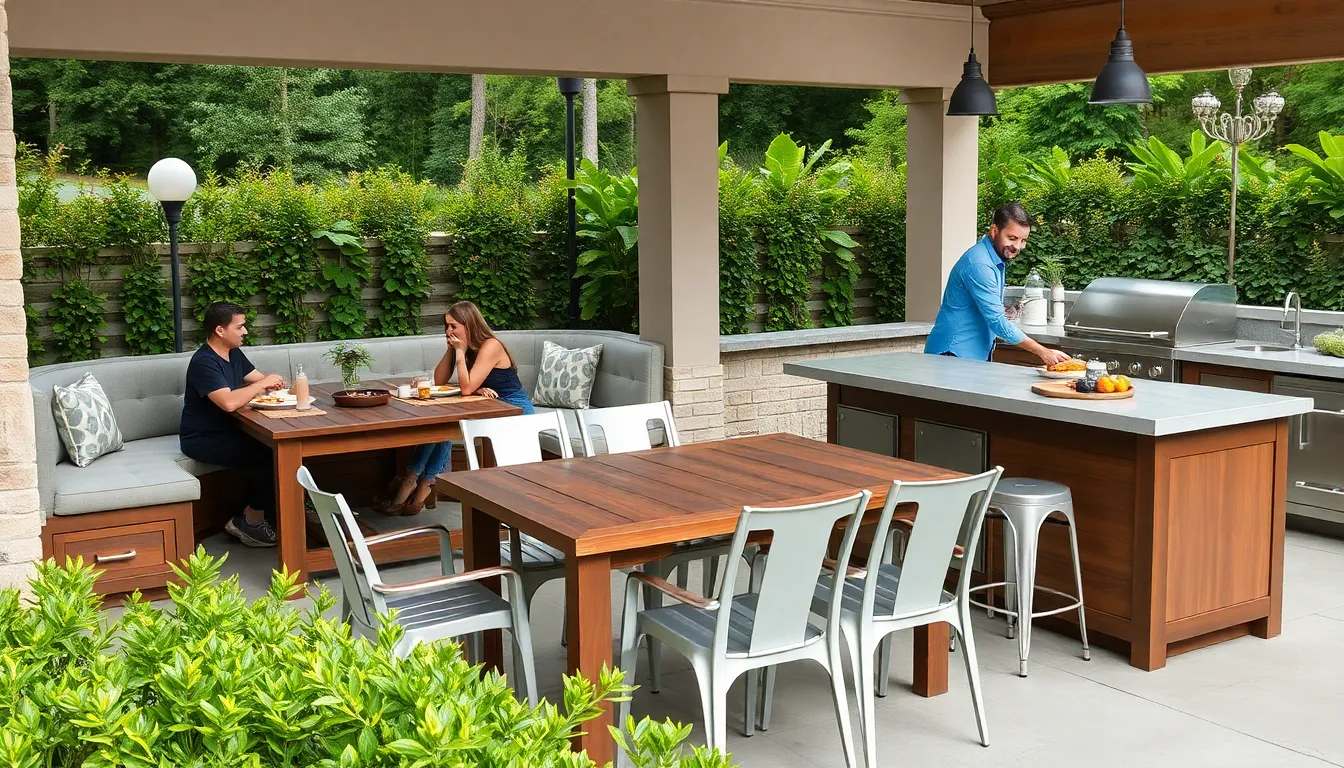
Creating comfortable seating and dining areas transforms your outdoor kitchen into a true entertainment hub. Strategic placement of seating options ensures guests can relax while staying connected to the cooking action.
Built-In Bench Seating with Storage
Built-in bench seating with storage maximizes functionality while maintaining clean lines in your outdoor kitchen design. We recommend incorporating weather-resistant cushions and pillows that can be stored directly beneath the seating when not in use. Storage compartments keep essential items like outdoor utensils, linens, and serving dishes organized and easily accessible during gatherings.
Custom built benches offer flexibility in sizing to fit your exact space requirements. Materials like cedar, teak, or composite decking provide durability against weather conditions while requiring minimal maintenance. Adding hinged tops to storage compartments creates seamless access while protecting contents from moisture and debris.
Strategic positioning of built-in seating along kitchen islands or perimeter walls creates intimate conversation areas. We suggest placing benches at comfortable distances from cooking areas to keep guests engaged without interfering with food preparation activities.
Outdoor Dining Tables and Chair Options
Outdoor dining tables and chairs must withstand temperature fluctuations, UV exposure, and moisture while providing lasting comfort. Durable materials like aluminum, stainless steel, and high-density polyethylene offer excellent weather resistance without sacrificing style. Teak and eucalyptus wood options provide natural beauty with proper maintenance and seasonal care.
Extendable dining tables accommodate varying group sizes from intimate family meals to larger entertainment gatherings. We recommend tables with umbrella holes for shade options during daytime dining. Stackable chairs offer convenient storage answers when entertaining space needs to be maximized for other activities.
Recycled plastic furniture presents eco-friendly alternatives that resist fading, cracking, and warping in extreme weather conditions. These options come in various colors and styles to complement your outdoor kitchen’s aesthetic while requiring virtually no maintenance throughout their lifespan.
Bar Seating for Casual Gatherings
Bar seating creates interactive spaces where guests can engage with the cooking process while socializing comfortably. Counter-height seating integrated into kitchen islands allows for seamless conversation between cooks and guests during food preparation. We suggest positioning bar stools at 24 to 26-inch heights to accommodate standard 36-inch counter elevations.
Swivel bar stools enhance functionality by allowing guests to easily turn toward different conversation areas or cooking stations. Weather-resistant materials like powder-coated aluminum frames with quick-dry foam cushions provide comfort while standing up to outdoor conditions. Footrests become essential for extended seating comfort during longer gatherings.
Standalone bar areas positioned away from active cooking zones offer additional seating without crowding workspace areas. Custom bar tops using materials like concrete, granite, or stainless steel coordinate with existing countertop selections while providing dedicated spaces for beverages and appetizers during casual entertaining sessions.
Budget-Friendly DIY Outdoor Kitchen Projects
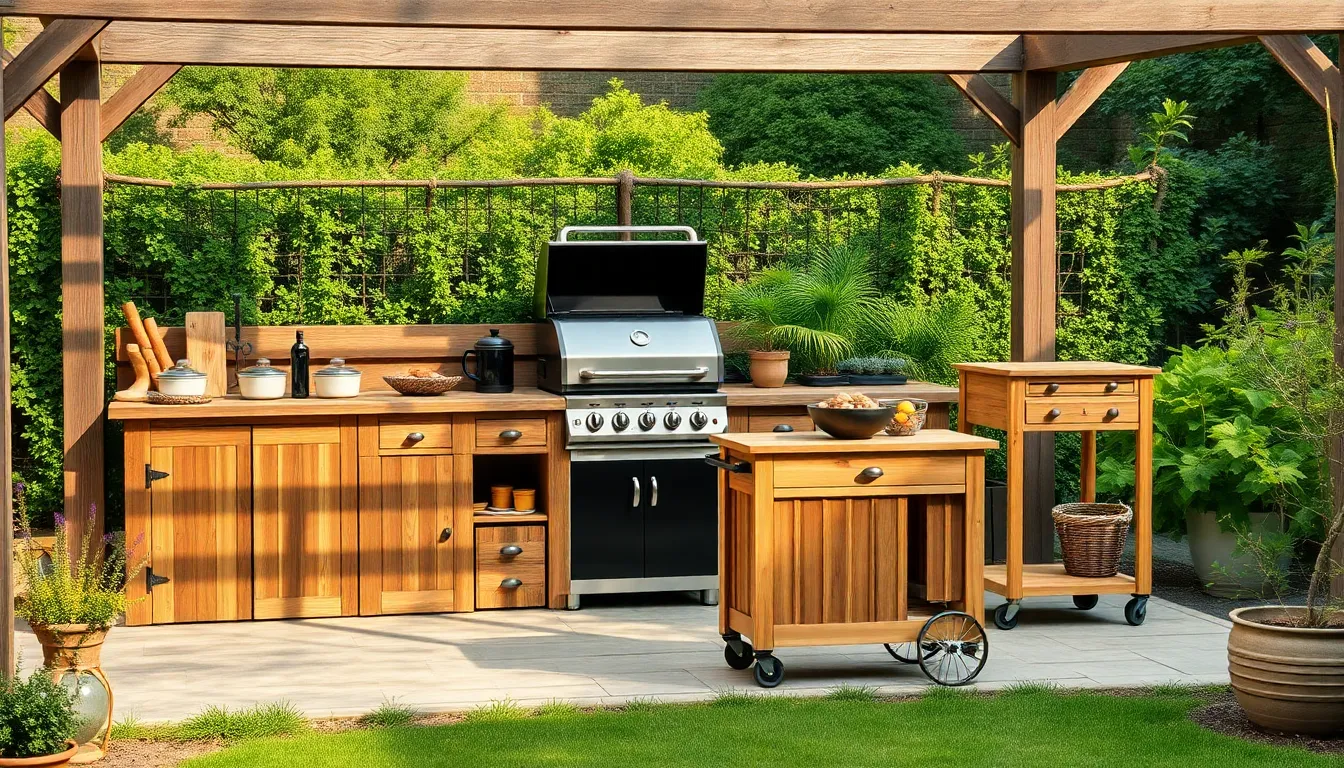
Creating an impressive outdoor kitchen doesn’t require very costly when you approach it strategically with DIY answers. Smart planning and resourceful material choices can deliver professional results at a fraction of traditional costs.
Simple Grill Stations and Prep Areas
Building a basic grill station starts with constructing a simple table paired with a wood slat wall for both storage and visual appeal. This combination provides essential workspace while keeping tools and accessories organized within easy reach.
Rolling carts offer flexibility as compact outdoor kitchens that can hold cooking tools, seasonings, and snacks while moving wherever you need them most. These portable answers work perfectly for smaller spaces or temporary setups.
Adding extra prep space becomes effortless with a stylish wooden buffet table that doubles as serving area and storage. Position these tables strategically to create efficient workflow between your grill and dining areas.
Repurposed Materials for Unique Designs
Reclaimed wood countertops transform old pallets or garden timbers into rustic surfaces that add character to your outdoor kitchen setup. These materials cost significantly less than new lumber while providing authentic weathered aesthetics.
Upcycled decorative elements like old metal signs or repurposed metal fixtures create unique focal points that reflect your personal style. These vintage touches often become conversation starters during gatherings.
Modular units constructed from reclaimed materials can feature integrated spaces for charcoal grills, turkey fryers, and butcher block countertops. This approach allows you to customize configurations based on available materials and exact cooking needs.
Phased Construction Approaches
Design sourcing cycles help you start with basic concepts while adapting your plans to available materials as opportunities arise. This flexible method prevents overspending while maintaining design integrity throughout the project.
Phase by phase construction begins with essential components like grill stations before expanding to include additional features over time. This approach spreads costs across multiple seasons while allowing you to test functionality before major investments.
Weatherproofing considerations should include materials like stainless steel and weather resistant countertops to protect your investment from harsh elements. Energy efficient options such as solar powered lights reduce long term operating costs while supporting sustainable practices.
Conclusion
Creating the perfect outdoor kitchen transforms how we experience our homes and connect with family and friends. Whether we’re investing in a complete renovation or starting with simple DIY projects we can build an entertainment space that brings joy for years to come.
The key lies in thoughtful planning that balances our budget lifestyle and long-term goals. From selecting weather-resistant materials to incorporating smart storage answers every decision shapes how we’ll use and enjoy our outdoor culinary space.
We’ve explored countless possibilities from modern minimalist designs to rustic country themes and budget-friendly approaches that prove impressive results don’t always require massive investments. With proper planning and creative vision we can transform any backyard into an outdoor kitchen that becomes the heart of our home’s entertainment experience.
Frequently Asked Questions
What is the recommended budget for an outdoor kitchen renovation?
Experts recommend allocating 10-15% of your home’s value for outdoor kitchen renovations. Basic setups can start around $5,000, while luxury installations can exceed $50,000. The budget should account for appliances, materials, electrical work, plumbing, and permits. Consider a phased approach to spread costs over time while gradually building your dream outdoor kitchen.
What are the essential appliances needed for an outdoor kitchen?
The must-have appliances include a high-performance grill (gas, charcoal, or pellet), weather-resistant refrigeration, and adequate storage solutions. Consider adding a smoker for barbecue enthusiasts, an outdoor pizza oven for versatility, and an ice maker for convenience. Choose appliances specifically designed for outdoor use to ensure durability and weather resistance.
How much space do I need for an outdoor kitchen?
Space requirements vary based on your design goals. A basic grill station needs about 6×8 feet, while a full outdoor kitchen requires 12×20 feet or more. Consider workflow zones: cooking, prep, storage, and dining areas. Ensure adequate clearance around appliances and maintain proper distances from property lines and structures per local codes.
What are the best countertop materials for outdoor kitchens?
Top choices include granite, quartz, concrete, and stainless steel. Granite offers natural beauty and heat resistance, while quartz provides non-porous durability. Concrete allows for custom shapes and integrated features, and stainless steel delivers professional aesthetics with easy maintenance. Choose materials that can withstand temperature fluctuations and UV exposure.
Do I need permits for building an outdoor kitchen?
Most outdoor kitchen projects require permits, especially those involving electrical, plumbing, or gas connections. Requirements vary by location and project scope. Consult with local building authorities early in the planning process. Professional contractors can help navigate permit requirements and ensure code compliance, preventing costly mistakes and safety issues.
What weather protection options are available for outdoor kitchens?
Popular options include pergolas for partial shade, gazebos for superior coverage, retractable awnings for flexibility, and enclosed pavilions for comprehensive protection. Consider your climate, budget, and usage patterns when choosing. Some structures can include climate control features for year-round use, while others provide basic sun and rain protection.
How should I plan the electrical system for my outdoor kitchen?
Install GFCI outlets for safety, position outlets strategically for appliance access, and use weather-resistant materials. Plan for adequate task lighting in prep areas, ambient lighting for entertainment, and dimmable controls for flexibility. Consider future electrical needs and consult with a licensed electrician to ensure proper installation and code compliance.
What flooring works best for outdoor kitchens?
Choose non-slip, weather-resistant materials like textured concrete, porcelain tiles, or rubber flooring. Prioritize surfaces that provide good traction when wet and are easy to clean. Consider decorative elements like Mediterranean-style tiles or integrated lighting strips. Ensure proper drainage to prevent water accumulation and slip hazards.
Can I build an outdoor kitchen on a tight budget?
Yes, through strategic planning and DIY approaches. Start with a simple grill station using repurposed materials like reclaimed wood. Use rolling carts for flexibility, build basic prep tables with storage, and implement phased construction to spread costs. Focus on essential elements first, then add features over time as budget allows.
How do I choose the right location for my outdoor kitchen?
Consider proximity to your indoor kitchen for convenience, prevailing wind patterns to avoid smoke issues, and access to utilities like gas, water, and electricity. Ensure adequate space for workflow and entertaining, maintain proper distances from property lines, and choose a location that complements your home’s architecture and landscape design.

